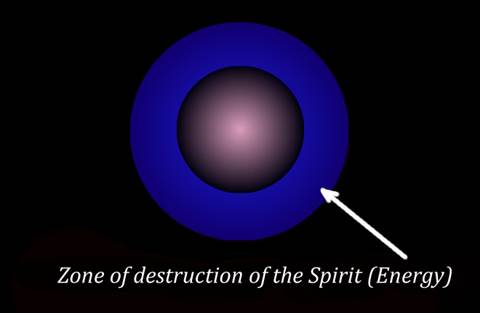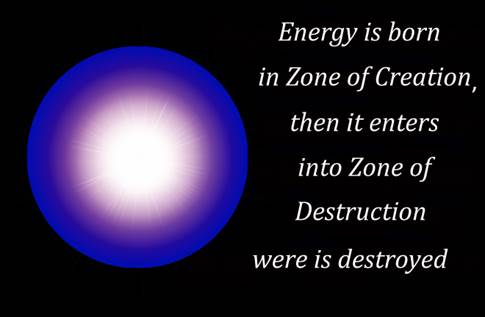THE STRUCTURE OF ELEMENTARY PARTICLES.
Any elementary particle is a sphere. Regardless of the quality, the radius any of them is the same for all existing particles. You should not to imagine the particle as a dense formation with solid walls. No, the particle is immersed in the air.
Particle - is a "point of contact of Creator", it is Something. Ether (Energy), filling the sphere at any given time, belongs only to this particle. All other particles can not at this moment in any way "pretend" to this ether, filling the particle. Each particle is characterized by a dual "relationships" with Ether (Energy-Information).
At the same time, each particle in a unit of time creates a certain amount of Ether. Appears Energy-Ether in the central part of the elementary particle – Zone ofCreation - and moves towards its periphery.
Thus the flow of Energy-Ether, produced in the central part of the sphere, and moving towards the periphery thereof, forms the body of the elementary particle.
Zone of Destruction does not distinguish between her own Ether, arising in it, and moving from the center to the periphery, as well as the Ether, which may come into the particle from outside. This Zone "anyway" for what Ether will destroy in it. Overview of it - with a certain speed to destroy Ether that enters into it. As you will see later, this "illegibility" of Zone of Destruction is the basis of a very curious law of nature - the Law of Transformation of external quality of particles. In turn, this law is so important and is the reason of so many natural phenomena that its role of a universal scale is difficult to overestimate. We will not go into details, but we give a simple example. Stars emit light only through the action of the Law of Transformation. In other words because the Zone of Destruction in elementary particles can absorb not only their own, and also external for them Ether. Ether, filling particles, is no different from the "free" Ether, outside the particles. It as though permeates every particle, "imbues" it like a sponge. Elementary particles like ephemeral spheres suspended therein. In all elementary particles, of any quality, Energy-Ether moves from the center to the periphery. The particles - are not closed form. They are open for entry of the Ether into them from the outside. Ether, which is outside the boundaries of the particle, does not belong to the particle and it in no way connected with it. As for the Ether that is emitted by particles with Repulsion Field, it ceases to have anything to do with the particle immediately after being emitted. But the Ether, that fills the particle at given time, belong only to it. While moving the particles with the Field of Attraction they continue to make up for the lack of the Ether occurring in them, absorbing it in the course of the movement from the surrounding ether field. When moving the particles with the Field of Repulsion they do not cease to emit appearing in them an excess of Ether. ------------------------------------------------------------------------------------------------------------
|









